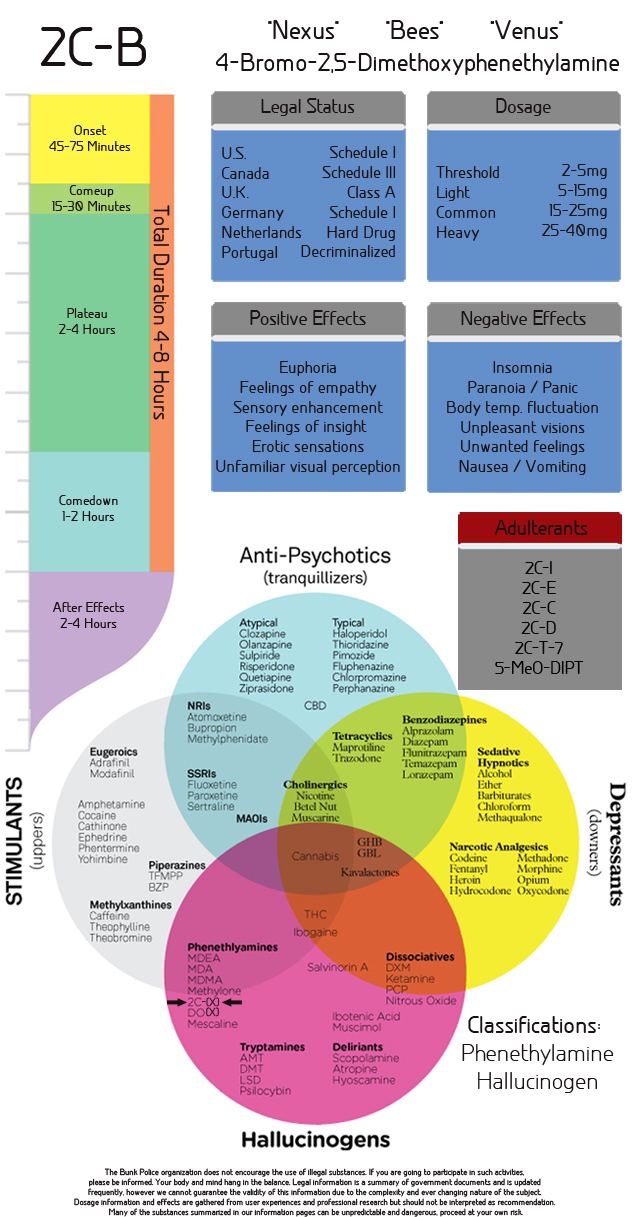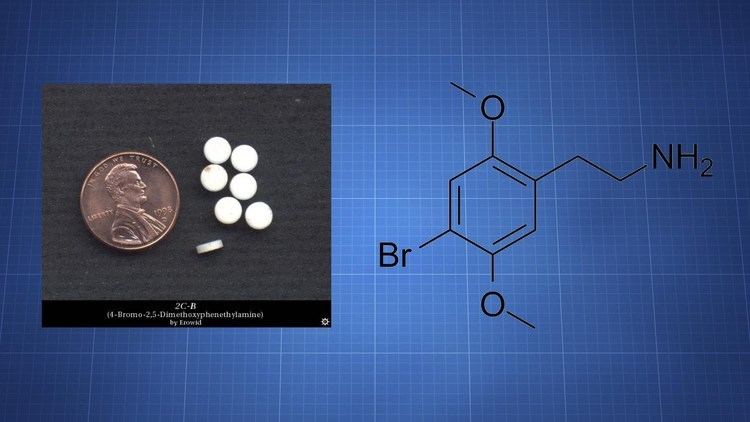CAS Number 66142-81-2 DrugBank DB01537 UNII V77772N32H Molar mass 260.13 g/mol | PubChem CID 98527 ChemSpider 88978 Formula C10H14BrNO2 | |
 | ||
Legal status CA: Schedule IIIDE: Anlage I (Controlled)UK: Class AUS: Schedule IUN: Psychotropic Schedule II IUPAC ID 2-(4-bromo-2,5-dimethoxyphenyl)ethanamine | ||
2c b what you need to know
2C-B or 2,5-dimethoxy-4-bromophenethylamine is a psychedelic drug of the 2C family. It was first synthesized by Alexander Shulgin in 1974. In Shulgin's book PiHKAL, the dosage range is listed as 12–24 mg. 2C-B is sold as a white powder sometimes pressed in tablets or gel caps and is also referred to by a number of other names. The drug is usually taken orally, but can also be insufflated or vaporized.
Contents
- 2c b what you need to know
- History
- Patterns of use
- Toxicity and dosage
- Effects
- Side effects
- Duration
- Pharmacology
- Metabolism
- N substituted derivatives
- Entheogenic use
- United Nations
- Argentina
- Australia
- Brazil
- Belgium
- Canada
- Denmark
- Estonia
- Germany
- Italy
- Japan
- Netherlands
- Norway
- Poland
- Spain
- Sweden
- Switzerland
- UK
- United States
- References

History

2C-B was synthesized from 2,5-dimethoxybenzaldehyde by Alexander Shulgin in 1974. It first saw use among the psychiatric community as an aid during therapy. It was considered one of the best drugs for this purpose because of its short duration, relative absence of side effects, and comparably mild nature. Shortly after becoming popular in the medical community, it became popular recreationally. 2C-B was first sold commercially as an aphrodisiac under the trade name "Erox", which was manufactured by the German pharmaceutical company Drittewelle. For several years, it was available as tablets in Dutch smart shops under the name "Nexus".
Internationally, 2C-B is a Schedule II drug under the Convention on Psychotropic Substances. In the Netherlands, 2C-B became a list I substance of the Opium Law despite no health incidents occurring. Following the ban, other phenethylamines were sold in place of 2C-B until the Netherlands became the first country in the world to ban 2C-I, 2C-T-2 and 2C-T-7 alongside 2C-B.

In the United States, a notice of proposed rulemaking published on December 20, 1994 in the Federal Register and after a review of relevant data, the Deputy Administrator of the Drug Enforcement Administration (DEA) proposed to place 4-bromo-2,5-DMPEA into Schedule I, making 2C-B illegal in the United States. This became permanent law on July 2, 1995.
Patterns of use

2C-B first became popularized in the United States as a short-lived legal substitute for the street drug Ecstasy when MDMA became illegal in 1985. Many 2C-B users are young adults who attend raves. Though 2C-B is still used in the rave subculture, commonly mistaken for and/or sold as Ecstasy, its intentional use has become more common. In recent years, 2C-B has emerged as the drug of choice for club drug users in Colombia.
Street prices range between $10 and $30 per tablet in the United States when bought in small quantities. Larger retail purchases cost between $200 and $500 per gram. Wholesale purchases of 2C-B can lower the price to a range of $100 to $300 per gram.
Toxicity and dosage
The September 1998 Journal of Analytical Toxicology reported that very little data exists about the pharmacological properties, metabolism, and toxicity of 2C-B. The relationship between its use and death are unknown. The common oral recreational dose is around 15–25 mg, at which visual and auditory effects are experienced. Severe adverse reactions are extremely rare, but use of 2C-B has been linked to significant injury in one case where the dosage is unknown, and the purity/identity of the chemical was not verified.
The lethal dosage is unknown. It was reported in PiHKAL, by Alexander Shulgin, that a psychologist had accidentally taken a 100 mg dose orally without apparent harm.
When sold as "Ecstasy", tablets containing 2C-B often contain about 5 mg of the drug, an amount which produces stimulatory effects that mimic the effects of MDMA; in contrast, tablets marketed as 2C-B have larger quantities of the drug (10–20 mg) which cause hallucinogenic effects. Street purity of 2C-B, when tested, has been found to be relatively high. Researchers in Spain found that 2C-B samples in the country doubled between 2006 and 2009, switched from primarily powder form to tablets, and exhibited "low falsification rates". An analysis of street samples in the Netherlands found impurities "in small percentages"; only one of the impurities, the N-acetyl derivative of 2C-B, could be identified and comprised 1.3% of the sample. The authors suggested that this compound was a by-product of 2C-B synthesis.
Effects
Little or no academic research has been conducted on the effects of 2C-B in humans. The information available is largely anecdotal and limited. Effects are often described as being more easily managed than other psychedelics; it is often compared to a mixture of a serotonergic psychedelic and MDMA. At 5–10 mg, experiments with young chickens have shown it to produce effects similar to a low dosage of amphetamines.
The anecdotal effects of 2C-B that have been reported by users on online discusion forums include:
The following effects are highly dose-dependent.
Side effects
Duration
When orally consumed, 2C-B has a much longer delay before the onset of effects than when it is insufflated. Oral ingestion generally takes roughly 45–75 minutes for the effects to be felt, plateau lasts 2–4 hours, and coming down lasts 1–2 hours. Rectal administration ("plugged") onset varies from 5–20 minutes. Insufflated onset takes 1–10 minutes for effects to be felt. The duration can last from 4 to 12 hours depending on ROA, dose, and other factors.
With insufflation the effects are more abrupt and intense but have a significantly shorter duration, while oral usage results in a milder, longer experience. When insufflated, the onset happens very rapidly, usually reaching the peak at about 20–40 minutes and plateauing for 2–3 hours. 2C-B is also considered one of the most painful drugs to insufflate, with users reporting intense nasal burning lasting as long as 30 minutes. The sudden intensity of the experience combined with the pain can often start the experience with a negative imprint and nausea is also increased with insufflation, compounding the issue.
Pharmacology
Unlike most hallucinogens, 2C-B has been shown to be a low efficacy serotonin 5-HT2A receptor partial agonist or even full antagonist. This suggests that the 5-HT2C receptor is primarily responsible for mediating the effects experienced by users of 2C-B, although functional antagonism of 5-HT2A or activation of the 5-HT2A-coupled phospholipase D pathway may also play a role. The rank order of 5-HT2A receptor antagonist potency for this family of drugs is 2C-I > 2C-B > 2C-D > 2C-H.
Research suggests that 2C-B increases dopamine levels in the brains of rats, which may contribute to its psychoactivity.
Metabolism
2C-B has been shown to be metabolized by liver hepatocytes resulting in deamination and demethylation that produces several products. Oxidative deamination results in the 2-(4-bromo-2,5-dimethoxyphenyl)-ethanol (BDMPE) and 4-bromo-2,5-dimethoxyphenylacetic acid (BDMPAA) metabolites. Additionally, 4-bromo-2,5-dimethoxybenzoic acid (BDMBA) can be produced also by oxidative deamination. Further metabolism of BDMPE and BDMPAA may occur by demethylation. Alternatively, the later metabolites can be generated by demethylation of 2C-B followed by oxidative deamination.
There is species differentiation in the metabolism of 2C-B. Mice hepatocytes produce 4-bromo-2,5-dimethoxy-phenol (BDMP) a previously unknown metabolite. 2-(4-bromo-2-hydroxy-5-methoxyphenyl)-ethanol (B-2-HMPE) was produced by hepatocytes from human, monkey and rabbit but not by dog, rat and mouse. 2C-B also reduces aggressor responses in drugged rats.
N-substituted derivatives
A variety of N-substituted derivatives of 2C-B have been tested, including N-methyl-2CB, N,N-dimethyl-2CB, N-ethyl-2CB and N-benzyl-2CB. Most simple alkyl derivatives were considerably less potent than 2C-B, with N-ethyl-2CB for instance having around 40× lower affinity at the 5-HT2A receptor. The N-benzyl derivative however was found to have higher binding affinity than 2C-B itself, with N-(4-bromobenzyl)-2CB binding even more tightly again. This initial research did not include functional assays of activity, but later led to the development of potent substituted N-benzyl derivatives such as 25B-NBOMe.
Entheogenic use
2C-B is used as entheogen by the Sangoma, Nyanga, and Amagqirha people over their traditional plants; they refer to the chemical as Ubulawu Nomathotholo, which roughly translates to "Medicine of the Singing Ancestors".
United Nations
The UN Commission on Narcotic Drugs added 2C-B to Schedule II of the Convention on Psychotropic Substances in March 2001. LSD, psilocybin, and mescaline are in the more restrictive Schedule I.
2C-B is scheduled as a drug in most jurisdictions. The following is a partial list of territories where the substance has been scheduled.
Argentina
2C-B is controlled under the List 1, as well as other substances like 2C-I or 2C-T-2.
Australia
2C-B is controlled in Australia and on the list of substances subject to import and export controls (Appendix B:). It was placed on Schedule One of the Drugs Misuse and Trafficking Act when it first came to notice in 1994, when in a showcase legal battle chemist R. Simpson was charged with manufacturing the substance in Sydney NSW. Alexander Shulgin came to Australia to testify on behalf of the defense to no avail.
2C-B is not specifically listed in the Australia Poisons Standard (October 2015), however other drugs such as 2C-T-2 and 2C-I are making 2C-B fall under the Australian analogue act.
Brazil
In Brazil, 2C-B is a controlled substance making production, distribution, and possession illegal.
Belgium
In Belgium, 2C-B is a controlled substance making production, distribution, and possession illegal.
Canada
In Canada, 2C-B is classified under CDSA Schedule III as "4-Bromo-2,5-dimethoxybenzeneethanamine and any salt, isomer or salt of isomer thereof".
2C-B has been rescheduled (Schedule III), in a new amendment, taking effect on October 31, 2016. This is to include the other 2C-x analogues.
Denmark
In Denmark, 2C-B is listed as a category B drug.
Estonia
In Estonia, 2C-B is classified as Schedule I.
Germany
In Germany, 2C-B is controlled in the Betäubungsmittelgesetz (BtMG) Anlage I as "Bromdimethoxyphenethylamin" (BDMPEA).
Italy
2C-B is schedule I (tabella I)
Japan
In Japan, 2C-B was scheduled in 1998. It was previously marketed as "Performax".
Netherlands
In the Netherlands, 2C-B was scheduled on July 9, 1997.
Norway
In Norway, 2C-B was classified as Schedule II on March 22, 2004, listed as 4-bromo-2,5-dimethoxyphenethylamine.
Poland
2C-B is schedule I (I-P group) in Poland.
Spain
In Spain, 2C-B was added to Category 2 prohibited substances in 2002.
Sweden
2C-B was classified as Schedule I in Sweden on June 1, 2002. 2C-B was first classified as "health hazard" under the act Lagen om förbud mot vissa hälsofarliga varor (translated Act on the Prohibition of Certain Goods Dangerous to Health) as of April 1, 1999 under SFS 1999:58 that made it illegal to sell or possess. Then it became schedule I as of June 1, 2002, publicated in LVFS 2002:4 but mislabeled "2-CB" in the document. However, this was corrected in a new document, LVFS 2009:22 effective December 9, 2009.
Switzerland
In Switzerland, 2C-B is listed in Anhang D of the DetMV and is illegal to possess.
UK
All drugs in the 2C family are Class A under the 1971 Misuse of Drugs Act which means they are illegal to produce, supply or possess. Possession carries a maximum sentence of seven years imprisonment while supply is punishable by life imprisonment and an unlimited fine.
United States
In the United States, 2C-B is classified as CSA Schedule I Section (d) Subsection (3) 4-Bromo-2,5-dimethoxyphenethylamine.
